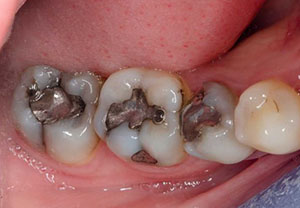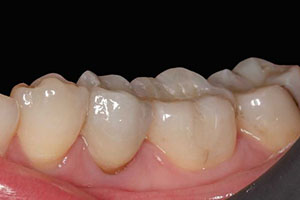Daily aesthetic dentistry: The contribution of the spectrophotometer
Dr. Edouard Lanoiselee, France
Introduction
Precise shade matching might be challenging even for very experienced practitioners. In this case report, the author demonstrates how to perform a simple and complete color analysis and optimize the transmission of color information to the laboratory, using a reproducible protocol.
 Case Report
Case Report
A 30-year-old female patient, with no contributory medical history, came to my dental office complaining about dental pain in the left mandibular quadrant. During the clinical examination, we observed a fracture of the lingual cusp of tooth #35, as well as old and failed amalgam restorations.
After isolation of the operating field with a dental dam, the amalgam restorations we removed and replaced with composite restorations (Essentia Universal, GC). Because of the massive destruction of tooth #35, we considered prosthetic restoration necessary to retain the tooth on the arch. Preparation was performed.
Shade Taking
Shade taking was performed using a Rayplicker device (Borea). The Rayplicker is a wireless spectrophotometer that enables one to obtain the following information in one acquisition:
• Polarized picture
• Translucency
• Overall shade
• Three-part mapping
• Nine-part mapping
• Detailed tooth mapping
A production file is then created directly in the Rayplicker software and all information (shade analysis and production files) is sent via the cloud to the laboratory. Digital-LABS (Bongert Laboratory) specializes in the design and computer-assisted manufacture of optical impressions (all systems) for the realization of digital prostheses. For this case, a digital impression was also taken (TRIOS 3, 3Shape) before the final restoration was performed (IPS e.max Ceram, Ivoclar Vivadent).
The assembly was performed by gluing under dental dam isolation of the operating field, using a photopolymerizable composite (G-aenial Universal Injectable, GC). This technique makes removal of excess material easier.
 Conclusion
Conclusion
The use of the Rayplicker allows the dentist to perform a simple and complete color analysis, applicable for both direct and indirect restorations. It optimizes the transmission of color information to the laboratory, using a reproducible protocol. It allows the integration of clinical photographs, allowing the dental technician to characterize the tooth finely to make the restoration as harmonious as possible. The Rayplicker integrates fully in the digital workflow of a prosthetic procedure.
About the author
Dr Edouard Lanoiselée graduated from the Faculty of Dentistry of Université de Nantes in France and later obtained a M1 degree in medical sciences. He worked as a university hospital assistant in the prosthetics department at the teaching and research centre of the Nantes university hospital. Dr Lanoiselée is a lecturer in aesthetics at Université de Nantes. He is specialised in cemented restorations, and computer-aided design and manufacture, and is a partner at a general practice in Nozay in France.




